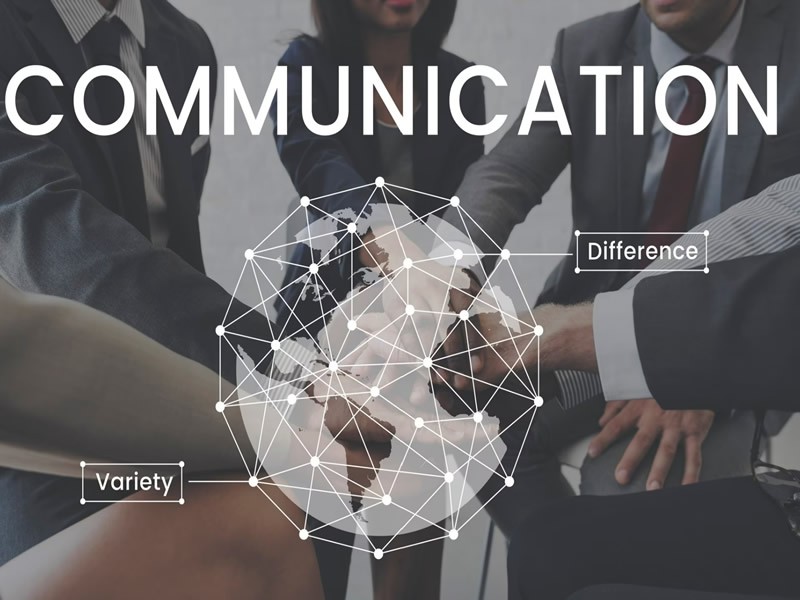Insight Blog
Agility’s perspectives on transforming the employee's experience throughout remote transformation using connected enterprise tools.
16 minutes reading time
(3173 words)
Understanding Communication Continuum – A 2025 Complete Guide
This comprehensive guide aims to provide you with a deep understanding of the Communication Continuum in 20235and how it can help you enhance your communication skills.
In today's digital age, effective communication is key to success, both in personal and professional settings.
With the ever-evolving landscape of technology and the advent of various internal communication platforms, it is crucial to understand the concept of the Communication Continuum.
This comprehensive guide aims to provide you with a deep understanding of the Communication Continuum in 2025 and how it can help you enhance your communication skills.
What is the Communication Continuum?
You maybe wondering what exactly is Communication Continuum, well it refers to the range of methods and channels that individuals and groups use to exchange information, ideas, and messages.
It encompasses various forms of communication, from face-to-face conversations and written letters to phone calls, emails, instant messaging, and social media platforms.
At one end of the continuum, we have synchronous communication, which involves real-time interaction between participants.
This includes in-person conversations, phone calls, video conferences, and live chats.
Synchronous communication allows for immediate feedback and often enables a deeper level of engagement.
On the other end of the continuum, we find asynchronous communication, which does not require immediate or simultaneous interaction.
Examples of asynchronous communication include emails, text messages, voicemails, and social media posts.
These forms of communication allow individuals to send and receive messages at their convenience, without the need for both parties to be present at the same time.
The Communication Continuum acknowledges that different communication methods have distinct advantages and limitations.
Some situations may call for face-to-face interaction to build rapport and convey complex emotions effectively, while others may require the efficiency and convenience of written messages.
Communication Continuum helps individuals and organizations make informed choices about the most appropriate communication channels to use based on the context, purpose, and desired outcomes of their interactions. Interpersonal communication continuum and communication lets dig a bit deeper and understand a bit more about this topic.
Understanding Communication Continuum
Interpersonal communication can be categorized into three methods: visual, verbal, and physical.
These methods differ in their level of intensity, with visual being the most indirect and physical being the most direct form of communication.
Visual communication can be compared to body language, which effectively conveys messages to a large number of people with minimal effort.
For instance, in crowded city spaces, body language is commonly used by urban dwellers to navigate through the crowds. However, visual communication is also the most ambiguous method, as it can be easily ignored or misinterpreted.
Likewise, individuals can feign ignorance or claim their actions were unintentional when confronted with the impact of their body language.
Verbal communication requires more direct interaction, as individuals engage in direct conversations with one or more people.
While verbal communication demands more effort, it offers greater clarity. When combined with body language, verbal communication becomes a highly effective means of expressing ideas and intentions.
Physical communication involves direct physical contact with another person and usually occurs on a one-on-one basis. Extreme cases of physical communication include acts of violence. Unlike visual and verbal communication or identity communication continuum, physical communication is nearly impossible to ignore.
Consider a woman navigating a city known for street harassment. Initially, she may rely on body language to communicate her unwillingness to interact with strangers. Most men will recognize her cues and leave her alone.
However, street harassers, by their nature, ignore acceptable social communication norms and choose to disregard her indirect visual communication. Instead, they interrupt with direct verbal communication.
In this scenario, the woman's indirect method of communication fails, requiring her to escalate to verbal communication in order to convey her original message. The easiest transition is to verbally state the same message her body language has been expressing: "Not interested!"
This concise statement signifies her lack of interest in engaging with the harasser in any way.
Emotionally, it is easier to make the escalating transition to a verbal "Not interested!" rather than delivering a more confrontational statement like "Stop harassing me!" The latter implies a change in the message, communicating, "You are bothering me, and I want you to stop bothering me!" To effectively deliver this message, the woman would have to stop and directly face her harasser, which would require an emotional willingness to engage with the harasser, which she likely does not desire.
Only when the harasser's behavior has angered her would she want to directly interact with him. In all other situations, the harasser's repulsive behavior would make her even less interested in engaging. Hence, the natural escalation of the message is the verbal statement "Not interested!" The next step would be to use physical communication, such as pushing the harasser away if he invades her personal space.
Therefore, the "Not interested!" communication continuum consists of body language, verbal statements, and, if necessary, physical push-away. These escalating responses are designed to de-escalate harassment as it occurs.
Applications of Communication
Communication plays a vital role in various aspects of our personal and professional lives. Here are some applications of communication:
1.Personal Communication
Communication is essential for establishing and maintaining personal relationships. It allows individuals to express their thoughts, feelings, and ideas, fostering understanding and connection between family members, friends, and partners
2.Business Communication
Effective communication is crucial in the business world. It facilitates the exchange of information, ideas, and feedback among employees, teams, departments, and management. Clear and concise communication helps in decision-making, problem-solving, and building strong professional relationships.
3.Education Communication
Communication is fundamental in the field of education. Teachers use communication to impart knowledge, explain concepts, and engage with students. Students, in turn, communicate with their teachers to seek clarification, ask questions, and participate in discussions. Effective communication enhances the learning experience for both educators and learners.
4.Media and Journalism
Communication is at the core of media and journalism. Journalists use various channels, such as print, television, radio, and digital platforms, to convey news and information to the public. Effective communication skills enable journalists to gather accurate information, conduct interviews, and present stories in a compelling and informative manner.
5.Public Speaking
Public speaking is a specific form of communication that involves addressing a large audience. It is essential in areas such as politics, business presentations, conferences, and seminars. Public speakers use effective communication techniques to engage, persuade, and inspire their audience.
6.Diplomacy and International Relations
Communication plays a crucial role in diplomacy and international relations. It allows diplomats and representatives from different countries to exchange ideas, negotiate agreements, resolve conflicts, and maintain diplomatic relationships. Effective communication is essential in promoting understanding and cooperation among nations.
7.Healthcare
Effective communication is vital in the healthcare sector. Doctors, nurses, and other healthcare professionals need to communicate clearly with patients to understand their symptoms, provide appropriate care, and explain treatment plans. Good communication skills also help healthcare providers work effectively as a team and ensure accurate transfer of information—something Emitrr helps enhance.
8.Social Media and Online Communication
In the digital age, communication has expanded to include social media platforms, online forums, and messaging apps. These platforms allow individuals to connect, share information, and express their opinions on a global scale. Online communication has transformed the way we interact, collaborate, and access information.
These are just a few examples of the wide-ranging applications of communication. Effective communication skills are essential in almost every aspect of life, enabling us to connect, collaborate, and thrive in various personal, professional, and social contexts.
Communication Continuum Examples
These examples demonstrate different points along the communication continuum, showcasing various forms and channels of communication, as well as the contexts in which they occur.
1.Face-to-Face Conversation
Two colleagues sitting in a meeting room discussing a project face-to-face. They exchange ideas, ask questions, and provide immediate feedback, utilizing both verbal and non-verbal cues such as facial expressions and body language.
2.Telephone Conversation
Two colleagues sitting in a meeting room discussing a project face-to-face. They exchange ideas, ask questions, and provide immediate feedback, utilizing both verbal and non-verbal cues such as facial expressions and body language.
3.Video Conference
A sales representative contacts a potential client over the phone to discuss a product or service. They engage in a conversation, conveying information, addressing concerns, and negotiating terms, relying solely on vocal communication without visual cues.
4.Email Correspondence
A manager sends an email to their team outlining the objectives and deliverables for an upcoming project. The team members respond with their thoughts, questions, and progress updates, communicating asynchronously through written messages.
5.Social Media Interaction
A company uses social media platforms to engage with its customers. Customers leave comments, ask questions, and provide feedback on the company's posts. The company responds promptly, addressing concerns and building a dialogue with its audience.
6.Non-Verbal Communication
Two friends, who are sitting in a library studying, communicate non-verbally by using gestures, facial expressions, and eye contact. They convey their thoughts and emotions without speaking, maintaining a silent but understanding connection.
7.Written Report
A researcher prepares a comprehensive written report summarizing their findings and recommendations. The report is shared with stakeholders who need to review the information and make decisions based on the communicated content.
8.Public Speech
A politician delivers a speech to a large audience at a campaign rally. They use persuasive language, gestures, and vocal techniques to connect with the crowd, convey their message, and inspire action.
Communication Continuum In Technical Writing
Communication continuum in technical writing refers to the range of communication methods and channels used to convey technical information to a diverse audience. It encompasses a spectrum of communication modes, ranging from highly formal and structured to more informal and interactive approaches.
Technical writers employ different strategies along this continuum to effectively communicate complex information to readers with varying levels of expertise and knowledge.
At one end of the continuum, we find formal technical writing, which includes detailed reports, user manuals, and scientific research papers. These documents follow a specific structure, use technical terminology, and provide in-depth explanations of complex concepts.
The language is precise and concise, focusing on accuracy and clarity. The writing style is typically impersonal and objective, avoiding personal opinions or emotions. This formal approach is often employed when communicating with expert audiences who require precise technical information.
Moving along the continuum, we encounter more user-focused communication. This includes instructional guides, online tutorials, and FAQs. Here, the language becomes more user-friendly and accessible, employing simpler vocabulary and providing step-by-step instructions.
Technical writers anticipate user needs and address common questions or issues to facilitate understanding and successful use of a product or service. Visual aids, such as diagrams or screenshots, may be included to enhance comprehension.
As we progress further, we encounter interactive communication methods, such as online forums, chatbots, or interactive help systems. These tools allow users to engage in real-time conversations and receive immediate assistance.
Technical writers may provide on-demand support by addressing specific questions, troubleshooting problems, or guiding users through complex tasks. This form of communication fosters active engagement and empowers users to find solutions independently.
Additionally, the communication continuum in technical writing extends to multimedia formats. Technical writers incorporate videos, animations, and infographics to present information in a visually appealing and engaging manner.
These mediums can simplify complex concepts, enhance user comprehension, and cater to different learning styles.
In all stages of the communication continuum in technical writing, the intended audience remains a central consideration. Technical writers analyze their readers' needs, preferences, and knowledge levels to determine the most appropriate communication approach.
They adapt their writing style, vocabulary, and use of visual aids accordingly to ensure the information is effectively conveyed and understood.
The communication continuum in technical writing emphasizes the flexibility and adaptability of communication methods.
Technical writers employ a range of strategies to bridge the gap between technical information and the intended audience, ensuring that complex concepts are effectively communicated in a manner that promotes comprehension and usability.
By leveraging different communication modes and channels, technical writers can cater to a diverse range of readers and facilitate the successful transfer of technical knowledge.
Encouraging a communication continuum in the workplace
Encouraging a communication continuum in the workplace is crucial for fostering collaboration, efficiency, and innovation. Here are some ways to promote and enhance communication continuum in the workplace in 2025.
1.Cultivate a Communication-Friendly Environment
Create a culture that values open and transparent communication. Encourage employees to share their thoughts, ideas, and concerns without fear of judgment or reprisal. Foster an environment where everyone feels comfortable expressing their opinions and actively listening to others.
2.Embrace Technology
Leverage technology tools and platforms that facilitate communication continuum. Utilize project management software, instant messaging platforms, video conferencing tools, and collaborative platforms to enable seamless communication and knowledge sharing among teams, especially if they are geographically dispersed or working remotely.
3.Promote Active Listening
Encourage active listening among employees by providing training and resources on effective listening techniques. Emphasize the importance of understanding others' perspectives, asking clarifying questions, and acknowledging their input. Actively listening fosters better understanding and promotes a more inclusive communication culture.
4.Establish Clear Communication Channels
Define and establish clear channels for communication within the organization. This includes formal channels such as team meetings, email updates, and project management systems, as well as informal channels like social gatherings or virtual coffee breaks. Ensure that employees are aware of these channels and know when and how to use them appropriately.
5.Encourage Regular Feedback
Foster a feedback-oriented culture where employees provide constructive feedback to one another. Encourage the use of feedback mechanisms such as peer reviews, 360-degree feedback, or suggestion boxes. Regular feedback promotes continuous improvement and helps address any communication gaps or challenges.
6.Encourage Cross-Functional Collaboration
Promote collaboration across different departments and teams. Encourage employees to work together on cross-functional projects or participate in interdepartmental meetings. This encourages diverse perspectives and knowledge sharing, enhancing the overall communication continuum within the organization.
7.Provide Communication Training
Offer training programs or workshops focused on effective communication skills.
These sessions can cover topics such as active listening, conflict resolution, giving and receiving feedback, and non-verbal communication. By investing in communication training, employees can enhance their communication skills and contribute to a more effective and cohesive work environment.
8.Lead by Example
Leaders and managers should exemplify effective communication practices. They should demonstrate active listening, encourage open dialogue, and provide regular updates and feedback. When leaders prioritize communication, it sets a positive tone and encourages employees at all levels to follow suit.
Leveraging Traditional Communication Channels
While digital communication platforms have become increasingly prevalent, traditional communication channels still hold significant value. Face-to-face interactions, for instance, enable you to establish trust, convey emotions, and build meaningful connections. Phone calls allow for immediate feedback and personal touch.
Understanding when and how to utilize these traditional channels within the Communication Continuum can set you apart in a world dominated by digital communication.
Harnessing the Power of Digital Communication
In the digital age, digital communication platforms play a pivotal role in our daily lives. Emails provide a formal and professional means of communication, enabling effective correspondence across distances and time zones.
Social media platforms allow for real-time engagement and interaction with a broad audience, facilitating brand awareness and customer engagement.
Video conferencing bridges the gap between physical and virtual presence, making remote collaboration seamless.
By embracing these digital channels, individuals and businesses can expand their reach and connect with people globally.
The Role of Content Marketing in Communication
Within the Communication Continuum, content marketing plays a vital role in capturing and engaging audiences. By producing high-quality, relevant content across various mediums such as blog articles, videos, and social media posts, businesses can attract, inform, and retain their target audience.
Implementing effective search engine optimization (SEO) strategies enables businesses to optimize their content for search engines, increasing visibility and driving organic traffic to their websites.
Maximizing SEO for Enhanced Visibility
Search engine optimization (SEO) is an integral part of the Communication Continuum, ensuring that your content reaches the right audience.
By incorporating relevant keywords, creating informative meta descriptions, and optimizing website structure and performance, you can improve your website's visibility in search engine results.
A comprehensive SEO strategy aligns your content with user intent, making it more likely to be discovered and outrank competing websites.
Wrapping up and The Future of the Communication Continuum
As technology continues to advance, the Communication Continuum will evolve further, presenting new opportunities and challenges.
It is essential to stay informed about emerging trends and adapt your communication strategies accordingly.
From the rise of artificial intelligence and chatbots to the integration of virtual and augmented reality, the future of the Communication Continuum holds immense potential for transforming how we connect and communicate with one another.
FAQ
What is the Communication Continuum?
The Communication Continuum is a theoretical framework that outlines the various stages and methods of communication, ranging from basic interpersonal skills to advanced counseling techniques. It helps in understanding how different communication methods impact interactions and outcomes.
The key components include:
- Source: The originator of the message.
- Message: The content being communicated.
- Channel: The medium used to convey the message.
- Receiver: The individual or group receiving the message.
- Feedback: The response from the receiver back to the source.
- Noise: Any interference that may distort the message.These components work together to facilitate effective communication.
How does the Communication Continuum apply to healthcare settings?
In healthcare, the Communication Continuum emphasizes the progression from primary communication skills, like active listening and empathy, to more advanced skills necessary for counseling and patient education.
This framework ensures that healthcare professionals can effectively interact with patients, enhancing care quality.
Why is understanding the Communication Continuum important in technical writing?
In technical writing, the Communication Continuum helps writers choose appropriate methods and channels to convey complex information effectively. It ensures that the content is accessible and understandable to diverse audiences, enhancing clarity and engagement.
How does the Communication Continuum affect team dynamics?
The Communication Continuum influences team dynamics by highlighting different communication styles and preferences. Understanding where team members fall on this continuum can improve collaboration, conflict resolution, and overall team effectiveness.
What challenges might arise when addressing the Communication Continuum in modern organizations?
Challenges include selecting appropriate communication channels among various options, managing information overload from asynchronous tools like emails, and ensuring that communication methods align with organizational goals and employee preferences.
Understanding these aspects of the Communication Continuum can enhance interpersonal interactions, improve organizational communication strategies, and contribute to more effective information dissemination.
Categories
Blog
(2626)
Business Management
(321)
Employee Engagement
(211)
Digital Transformation
(175)
Intranets
(120)
Growth
(119)
Remote Work
(61)
Sales
(48)
Collaboration
(37)
Culture
(29)
Project management
(29)
Customer Experience
(26)
Knowledge Management
(21)
Leadership
(20)
Comparisons
(6)
News
(1)
Ready to learn more? 👍
One platform to optimize, manage and track all of your teams. Your new digital workplace is a click away. 🚀
Free for 14 days, no credit card required.
















